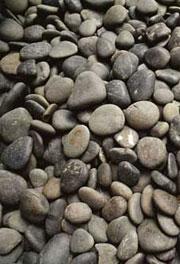 Mature pebbles stay the same basic 'shape' even as they get smaller with age.© Getty
Mature pebbles stay the same basic 'shape' even as they get smaller with age.© GettyA seaside conundrum has been solved: what shape is a pebble?
The answer, of course, is 'pebble-shaped'; but now, thanks to research by a team in France and the United States, it's possible to define what that means.
Technically speaking, says material physicist Doug Durian of the University of Pennsylvania in Philadelphia and his colleagues, a pebble is a rounded body with a near-gaussian distribution of curvatures. While no two pebbles are exactly alike, all seem to end up with this mathematical form1,2.
And once this shape is attained, it never changes (in lab experiments, at least). As a large pebble is ground down to a tiny grain, it retains this classic pebble shape.
Round and round
“A trained geologist might be able to tell how a pebble was made.”
Doug Durian,
University of Pennsylvania.
Aristotle proposed that the rounded shapes of pebbles arise because of faster erosion of parts furthest from the centre, which neatly explains why sharp corners get worn away. But although various proposals have been made for how to define a pebble's shape, including simply measuring its width, breadth and height, our understanding has not advanced much since Aristotle's time.
Durian and his colleagues say that the best way to define rounded shapes is in terms of their distributions of curvature (curvature being the radius of a circle that would match the contour at a given point). A sphere has equal curvature everywhere. But the curvature of a pebble varies from place to place.
Durian's team looked at pebbles of hardened mud formed at Mont St-Michel bay on the coast of northern France, where the tides produce flattish, dried mud fragments that are progressively eroded over many months. As erosion proceeds, the pebbles 'mature' from sharp-edged fragments to rounded forms.
Picture imperfect
They took 2-dimensional pictures of more than 60 pebbles at various states of erosion, and calculated the distribution of curvatures around the circumference of each pebble. They then plotted this distribution on a graph.
On such a graph, the curvature distribution of a circle would appear as a single spike. But the pebbles all showed a broad bell curve, with the more mature pebbles approaching a shape that can be described by a gaussian curve. Although the exact shapes of the mature pebbles varied, they all showed the same curvature distribution once past a certain stage of erosion.
Bashed about
ADVERTISEMENT
The researchers saw precisely the same thing for pebbles made in the laboratory from clay, moulded initially into various sharp-edged polygons (including triangles, squares and odd-shaped chunks) and then bashed about in a square metal pan to erode them. In this case, the curvature distribution was a little closer to the ideal gaussian form, says the team.
The distribution of curvatures, they say, doesn't seem to depend on the pebble's starting shape, but rather solely on the erosion process itself. Maybe softer, gentler erosion might lead to a narrower bell curve and a shape closer to a perfect circle, they posit.
This raises the possibility that experts might be able to tell whether a pebble was worn away by one kind of erosion (in a raging river, for example) or another (such as the slow wear in a glacier, or from the wind), just by looking at its shape. "A trained geologist might be able to tell the difference," says Durian. "But it has been hard to check that intuition."
Visit our shapeisapebble.html">newsblog to read and post comments about this story.
University of Pennsylvania.
-
References
- et al. Preprint http://www.arxiv.org/abs/cond-mat/0607061 (2006).
- et al. Preprint"http://www.arxiv.org/abs/cond-mat/0607122":http://www.arxiv.org/abs/cond-mat/0607122 (2006).
